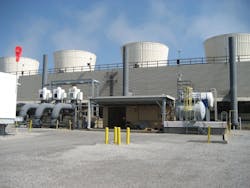Cambria Cogen Plant Converts to OPC
Cambria Cogeneration Co., located in Ebensburg, Pa., is an 85 MW, base-load, circulation fluidized bed (CFB) boiler plant, and is a Qualifying Facility that began commercial operations in March, 1991. Cambria Cogen is one of 13 plants currently owned by Northern Star Generation LLC (NSG) and is a privately held power generation company dedicated to providing reliable service to its customers, most of whom hold long-term contracts with NSG for power generation availability and energy production. Cambria Cogen has an agreement to supply power to the Pennsylvania Electric Company until March 2011. The waste coal burned by the plant helps eliminate the source of acid water runoff from waste coal piles in the area, and the ash produced by the plant is used beneficially to restore the landscape after the removal of the waste coal. Cambria Cogen started working with Canary Labs, based in Martinsburg, Pa., in 1998. The company has been using the Canary Labs Trend Historian and Trend Link products, connected to a Bailey distributed control system (DCS) via DDE with a Rovisys Server. For these past nine years, during which the Trend Historian tag count has grown to approximately 900 tags, Cambria Cogen has utilized Canary Labs’ maintenance and support program. In September of 2007, Cambria Cogen decided to upgrade from DDE to OPC for its data collection system. A new OPC server was purchased from Rovisys for the upgrade. During the conversion process, the latest versions of Trend Historian, Trend Link and the Rovisys Server were installed on a PC notebook and connected to the Bailey DCS system. The configuration of the server, trend chart files and data file conversion were completed and tested within two days and then moved to the primary system. The Canary Historian/Trending systems are used mainly as an engineering tool within the plant among different users. “It is just a great troubleshooting tool,” says John Anisberger of Cambria Cogen. Some users at the plant also use it as a financial tool to calculate MegaWatt sales. Now that the Cambria Cogen plant has converted to OPC, utilizing the OPC-compliant Canary software will assure interoperability and eliminate the need for expensive custom interfaces and drivers for moving information among systems for many years to come. For more information on OPC-based solutions from Canary Labs, visit www.canarylabs.com.

